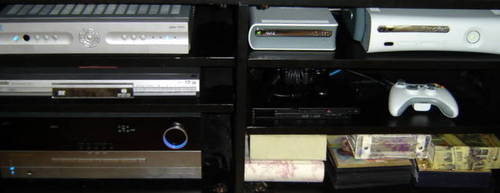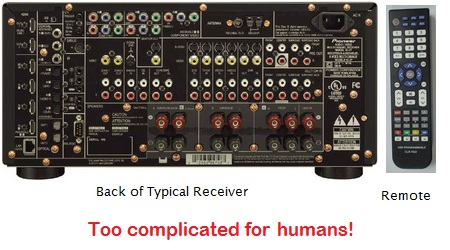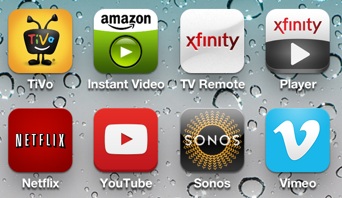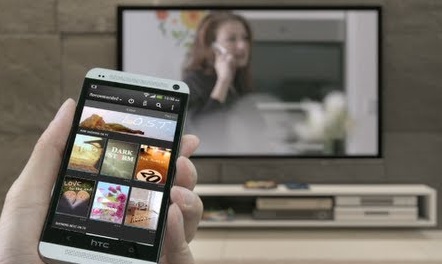Under my TV I have two game consoles, a TiVo DVR with CableCard, a pre-amp and amp, Sonos, cable modem and wifi router. A big mess. If you follow the tech and TV industry, you already know companies have been trying for years to combine this mess into a single box. It’s more of question of how this will happen, not if.
The Problem – TV has grown too complex
To start, let’s pause to recognize how bad the current situation is. We’ve reached the point where in many households only a couple people know how to turn on the TV and sound system. And even then, people often watch the low res regular definition channels instead of the HD channels. Lots of expensive gear people barely know how to use. Combining everything into a single box solves this problem.
Apps replacing channels. Small screens controlling big screens.
This simplification is happening in two ways. First, as Netflix likes to say “Apps will replace channels.” This is easier to understand looking at a screenshot of some apps on my phone right now.
I’ve got a TiVo app to control my tivo, Amazon app to play amazon video, netflix to play netflix, youtube, etc. Even my cable company Comcast has gotten into the game, providing both a remote control Xfinity app as well as an Xfinity player app to play Comcast cable content. Note that Netflix is available through my Tivo DVR and Playstation as well. Same for YouTube and various other content. While I don’t have them, there’s also apps for HBO Go, WatchESPN, MLB.tv. The point here is video content comes from apps. Apps replace channels.
Which leads to the second point. These apps not only play content, they can direct this content from my small screen (my phone) to my big screen (my TV). The small screen controls the big screen. This solves the usability problem of TVs being too complex for humans. Find what you want on your phone, and bump it across to your TV. I do this for YouTube now. Similarly you can do this for Apple TV (which I don’t own). And Microsoft’s Xbox also allows you to control the big screen with voice as well, making it easier to find what you want to watch.
The TV Box as general purpose Software Platform
Apps as the source of content have another huge implication. It means the box under your TV is becoming a general purpose software platform. And the thing about software platforms, aka operating systems (OS), is how few and far between they are. That’s because creating and maintaining an OS is technically incredibly difficult, and network effects tend to make OS’s a winner-take-all software category. Once a platform gets adopted in a particular market segment, it tends to dominate. As this wikipedia OS usage share summary demonstrates.
So which companies can play this game? The same ones who play it already in phones, desktops and servers. We’re talking Apple (Mac OS, iOS), Microsoft (Windows) and Google (Android, Chrome OS). Plus open source Linux.
Cord Cutting and CableCards
One side note here. As I posted previously, Cord Cutters who get all their video content over the internet are rare, and will continue to be so for a while. I’ve got a Tivo DVR with a CableCard, allowing me to get cable content without using the clunky cable box/DVR provided by my cable company. It’s a helpful transition technology, providing both cable content and app content in a single box.
Of course the key cable content providers like ESPN and HBO see which way things are going, and have made their content available as apps already. But….due to cable rights contracts, you can only get the app video content if you pay for a cable subscription. That’s why I don’t have HBO Go or ESPN on my phone. I don’t pay for them via cable. What this means is we have some quasi-cable cutters out there, who pay for cable but access content via apps. This sidesteps the poor user experience of the cable box. Anyway, digression over. Back to the big three players.
Prospects for Google, Microsoft, Apple on set top boxes
Google first. Google TV has been around a while. It uses a variant of Android to power a set top box. Seems perfect. But channel conflict with content providers has kept it small so far, and usability is really terrible. So it’s been a failure. Now I think having an Android based TV box is fine in principal. But what’s super hard is designing an easy to user interface and cracking a new market. Android for TV boxes sits where Android for phones was pre-iPhone. In any case, Google recently started shipping their $35 Chromecast dongle, which allows you to stream content to your TV from the web. And you control it via your phone or a web browser. This has been a success, especially because it has no user interface at all. It just drops what you are seeing on the small screen to the big screen. Google’s new approach is taking the very long view here, where there’s no need for a set top box of any sort in your home.
Microsoft second. The soon to be released Xbox One is being positioned as a general content delivery system rather than a pure play gaming system. This annoyed gamers of course, who are harshing on it and holding out for the new Playstation 4. But Ben Thompson’s take is “Xbox is too beholden to gaming and thus too expensive. Right idea, wrong execution. Classic Microsoft, actually.” That is, Microsoft should have pissed off gamers far more than they did. Exactly. They should be killing Tivo, not Playstation. For example it would have been great to integrate CableCard directly into Xbox One and adding DVR capability, rather than their “pass through” solution. If they had, I would drop my Tivo for an Xbox. Of course Microsoft has been executing on owning home entertainment for decades, so they’ll no doubt continue. Even if slowed by their desire to keep gamers happy.
Apple third. Currently Apple TV runs a modified iOS, which powers Apples phones and tables. But Apple TV, at a $99 price point, currently has hardware too weak for third party developers. Over time Moore’s Law will change this, and the hardware will become good enough for an app store at the same price point. One hint of this direction is that iOS 7 will run 64 bit, which is not really that helpful yet for phones but would be great in a TV box. More on that angle here. With that said, we shouldn’t expect a purist design house like Apple to support for legacy cable via CableCard. Like Google, they will target pure cord cutters, knowing this approach is a strategic strength and tactical weakness. Finally let me add a couple of choice Ben Thompson tweets: “PSA: Apple isn’t interested in Xbox/PS current market. That’s niche.” And “Whatever Apple releases will be a “worse” gaming experience than traditional consoles, at least according to gamers.”
Google, Microsoft and Apple’s approaches are distinct enough they aren’t competing head to head very much, at least for the moment. So it’s hard to predict who will come out ahead. Maybe they’ll all carve out a niche. But if I had to pick, I think we’ll wind up in a similar situation to the mobile market. Apple taking the premium end with an upgraded Apple TV running 64 bit iOS7, and supported by a third party app store and ecosystem which leverages their leadership in phone/tablets. Android TV boxes may belatedly take off once Apple validates the market, becoming the low end set top box. And Google’s $35 Chromecast dongle could become free and built into all TVs and receivers. Microsoft could muddle through here, but they’ll be squeezed on the high end by Apple and the low end by Google. Similar to phones, in a tough spot.
Other players. Samsung, Sony, Nintendo.
On to Samsung. Samsung’s an interesting case since they already make the complicated receivers humans can barely use. But they have huge ambitions. They are already shipping various Google TV boxes. Will they succeed? History says it’s possible. They would not really be inventing a new software platform, which would be too hard. Instead they’d just be leveraging Android and the Google TV ecosystem. But it’ll be a tough battle.
This leads us to Sony. Right now they have a dedicated gaming console with the Playstation. Could they make the jump to turning Playstation into a full software platform in the face of competition from Google, Microsoft and Apple? No. Of course for hard core gamers, you really need the physical game controller to play. And I don’t expect that Apple would make a game controller for Apple TV. But as a third party add on? Sure. Microsoft of course already has the games and the game controller. What appears to be happening short term is hard core gamers want the Playstation 4. Sony is stuck in a classic innovator’s dilemma. The more they make their existing customers happy, the worse off they are strategically.
Finally Nintendo. I don’t have much to add to what John Gruber and Lukas Mathis said as they duked it out. Obviously I’m in the Gruber camp, where Nintendo should start making iOS and Android games. Like Sony, their dedicated hardware is in strategic decline due to disruption from phones and tablets. And going forward Moore’s law ensures these generalized TV set top boxes will swallow the gaming market whole.





4 comments